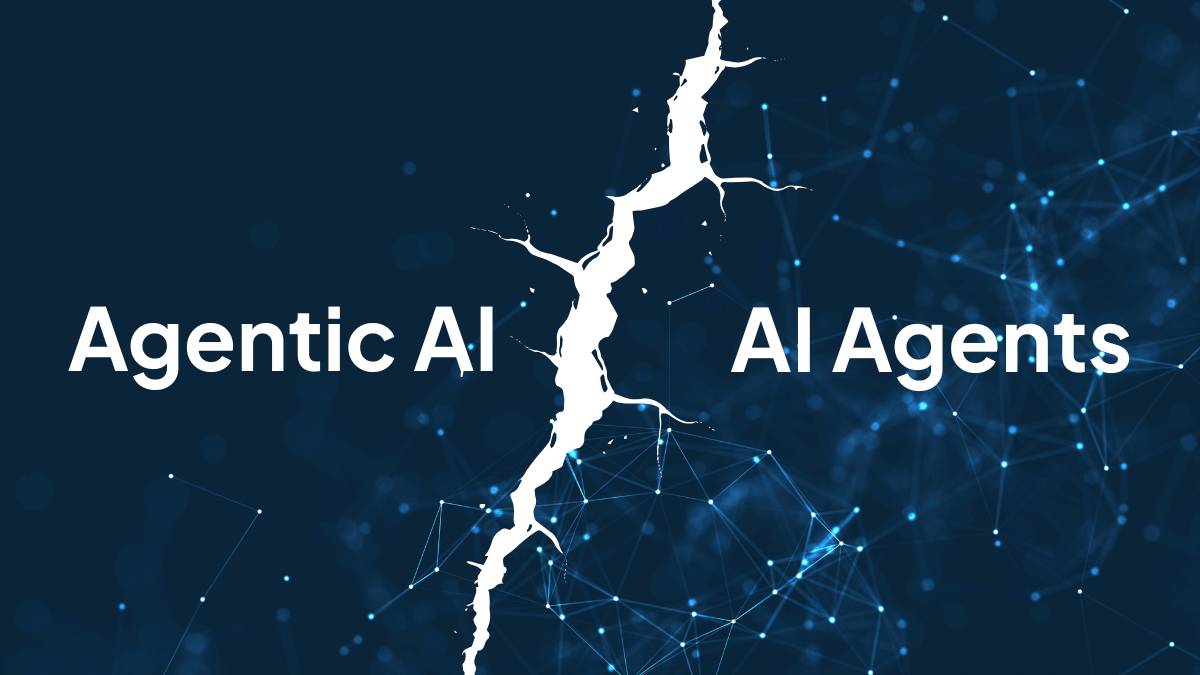Agentic AI and AI agents might sound like the same thing, but they’re not. Agentic AI vs AI Agents comes down to scope and adaptability. AI agents are built for specific, rule-based tasks like chatbots, reporting, or monitoring. They follow set instructions and work best with clear, structured inputs. Agentic AI, on the other hand, can plan, adapt, and operate across different domains toward broader goals.
It handles messy or changing situations, learns from outcomes, and needs less human oversight once set up. AI agents are faster and cheaper to deploy, while agentic AI suits complex, evolving challenges. Choosing between them depends on task complexity, budget, and how much autonomy you’re ready to give.
Table of Contents
Introduction to Agentic AI and AI Agents
Over the past couple of years, the way we talk about AI has changed a lot. Not too long ago, the term “AI agent” covered almost anything that could take an action without constant human input. Then people started building systems that weren’t just reacting – they were making longer-term decisions, setting sub-goals, and adapting when things shifted.
That’s where “agentic AI” comes into the picture. It’s not some flashy marketing term. It’s a way of describing AI that thinks a bit more like a project manager than a simple worker. You give it a target, and it doesn’t just wait for instructions – it figures out what steps to take, in what order, and changes course if needed.
The distinction matters now because businesses are deciding between keeping things simple with task-based automation, or investing in these bigger-picture systems that can operate with less hand-holding.
What Are AI Agents?
The easiest way to explain an AI agent is this: it’s a program that can see what’s going on around it, decide what to do, and then do it. That’s it.
Most of the time, it’s built for one clear purpose. It might:
- Monitor incoming emails and sort them.
- Respond to customer questions in a chat window.
- Scan for changes in stock prices and place trades automatically.
They can run in full-auto mode, or they can pause and ask for approval before acting. Either way, they stick to the task they were designed for. They don’t wake up one day and decide to do something different.
AI agents are great when you want reliability and speed on repetitive tasks. But they’re not “big thinkers.” They’re more like dependable tools than decision-makers.
What is Agentic AI?
Agentic AI starts from the same foundation as an AI agent but takes things a step further. Instead of being told exactly what to do, it’s given a goal – and then it works out the steps to get there.
This means it can:
- Weigh different options and pick the most promising path.
- Break a goal into smaller chunks and tackle them one by one.
- Adjust its plan if new information changes the situation.
You might see agentic AI running a long-term project, coordinating different tools, or handling situations where the rules aren’t fixed. For example, it could manage a supply chain that changes daily or run ongoing research where the data is constantly shifting.
It’s less about reacting to the moment and more about steering toward a destination. That’s what separates it from the typical task-focused AI agent.

Enroll Now: Ai Marketing Course
Agentic AI vs AI Agents: Comparison Table
| Aspect | AI Agents | Agentic AI |
| Core purpose | Good at set, repetitive jobs. Sticks to what it’s told. | Works toward a bigger goal and can change the plan if needed. |
| Main role | Reacts to inputs, follows rules. | Plans steps ahead and adjusts along the way. |
| Autonomy | Needs prompts or triggers to start. | Can start tasks and decide priorities on its own. |
| Decision style | Follows fixed logic. | Weighs options before acting. |
| Learning | Doesn’t change much unless updated. | Learns from results and improves over time. |
| Scope | One job, one environment. | Can work across different areas. |
| Integration | Quick to plug in. | Needs deeper setup and links to more systems. |
| Scalability | More agents = more output. | Scales in output and thinking ability. |
| Handling context | Works best with clear, clean data. | Can deal with messy, shifting info. |
| Use cases | Chatbots, reports, alerts. | Research, supply chain, product design. |
| Oversight | Needs checking in on. | Runs with light supervision once set. |
| Deployment time | Fast to launch. | Slower setup, bigger payoff later. |
| Risk | Low, predictable. | Higher risk if not managed closely. |
| Cost | Cheaper to run. | Higher upfront spend, better for complex needs. |
Also read: Rational Agents in AI: Working, Types and Examples
Advantages of Agentic AI Over Traditional AI Agents
1. Reduced human oversight
Once it’s set up right, you don’t have to keep checking on it. It can keep going on its own for quite a while. That means less babysitting and more time to focus on the bigger stuff.
2. Higher problem-solving capability
It’s better at figuring out what to do when things aren’t obvious. It can look at the situation, weigh options, and make a call without someone spelling out every single step.
3. Ability to handle unstructured and evolving scenarios
If the data’s messy or things change halfway through, basic agents can freeze up. This one can work around that, make sense of the scraps it’s got, and still push ahead.
4. Cross-domain knowledge transfer
What it learns in one area doesn’t just stay there. It can carry that over to other jobs, which makes it handy for businesses juggling different kinds of work.
Also read: Knowledge-Based Agents in AI: The Ultimate Guide
When to Use AI Agents vs Agentic AI
1. Project scope
Small, clear tasks? Go with an AI agent – it’ll get the job done without fuss. If the work has a lot of moving pieces and needs coordination, agentic AI is a better fit.
2. Budget and complexity
Agents cost less and are easier to get running. Agentic AI takes more money and effort upfront, but it can make that back if the work’s complicated and ongoing.
3. Regulatory compliance
In industries where every move has to be tracked and explained, AI agents are safer. Agentic AI can work here too, but you’ll need tighter controls.
4. Time-to-deployment needs
Agents can be live fast, especially for simple jobs. Agentic AI needs more setup time since it often connects to more systems and handles more tasks.
5. Industry examples
In healthcare, an AI agent might send out reminders. Agentic AI could manage the whole schedule around doctor availability. In logistics, an agent might give tracking updates, while agentic AI would plan the whole delivery route.
Also read: Main Goal of Generative AI
Key Use Cases for Agentic AI
1. Autonomous scientific research & data analysis
It can go through huge sets of information, spot patterns, and shift its focus as it learns more – all without someone nudging it along every step.
2. Dynamic supply chain optimization
Instead of just flagging a delay, it can change suppliers, reroute shipments, or tweak inventory based on what’s happening right now.
3. AI-driven product design
It can take in feedback, try out new variations, and keep improving the design so it matches what people actually want.
4. Multi-step customer journey personalization
It can guide a customer from the first interaction all the way through follow-up, adjusting messages and offers as it learns what works for that person.
Also Read: 10 Essential Skills to Build AI Agents
Key Use Cases for AI Agents
1. Customer support chatbots
These handle the basic questions and routine issues so your team doesn’t have to. They can respond instantly, any time of day, which keeps customers from waiting around.
2. Automated report generation
Pulls together numbers, charts, and summaries without someone having to dig through the data manually. Saves time and reduces the chance of human error in repetitive reporting.
3. Predictive maintenance alerts
Keeps an eye on equipment data and sends a warning before something breaks. That way, fixes can be planned instead of rushed.
4. Order tracking systems
Gives customers real-time updates on where their order is. Cuts down on “where’s my package?” calls and keeps people informed without extra effort from staff.
Also read: Generative AI vs Predictive AI: Key Differences
Challenges & Limitations
1. For AI Agents
Limited reasoning ability
They stick to the rules they’re given. If something unusual happens, they can struggle to figure out what to do next.
Narrow context handling
They do well in their set task but don’t see the bigger picture. If the job changes, you might have to reprogram them.
2. For Agentic AI
Higher computational requirements
They need more processing power and resources to run, which can make them more expensive to operate.
Ethical & transparency concerns
Because they act more independently, it’s not always clear why they make certain decisions. That can be a problem in regulated industries.
Potential overreach in autonomous decision-making
If they’re not given clear limits, they might take actions beyond what’s intended – which can cause problems if those decisions have big consequences.
Future of Agentic AI and AI Agents
1. Trends shaping the evolution of autonomous systems
More industries are moving toward systems that can adapt on their own. Expect to see them handling bigger chunks of work without constant input.
2. Role of large language models (LLMs) in enhancing both
LLMs can make both AI agents and agentic AI smarter by helping them understand and respond to more complex instructions.
3. The convergence point: hybrid AI systems
We’re likely heading toward setups that mix the strengths of both – agents for clear, structured jobs and agentic AI for bigger, shifting challenges.
Conclusion
AI agents and agentic AI may sound similar, but they serve different purposes. AI agents work best for clear, repetitive tasks where speed and consistency matter. Agentic AI is built for more complex, changing situations where planning and adaptation are key. Choosing between them comes down to your project’s scope, budget, and risk tolerance. If you just need to automate a routine process, an AI agent is the sensible choice. But if you want something that can think ahead, adjust on its own, and work across different areas, agentic AI is worth the extra investment. The right fit depends on where you need control, where you can give autonomy, and how fast you need results.
FAQs on Agentic AI vs AI Agents
Is agentic AI just an advanced form of AI agents?
Not exactly. It builds on some agent concepts but adds broader goals, planning, and the ability to adapt as things change.
Can a single AI system use both approaches?
Yes. Many setups use AI agents for routine work and agentic AI for the harder, more strategic tasks.
Which is more cost-effective for startups?
Usually AI agents, since they’re cheaper to set up. But agentic AI might pay off if the work is complex from the start.
How does LLM integration affect both models?
It helps them understand instructions better and work with more varied data, making both more capable in their own ways.
Are there security concerns unique to agentic AI?
Yes. Its higher autonomy means you need stronger safeguards to stop it from making decisions outside the intended scope.

